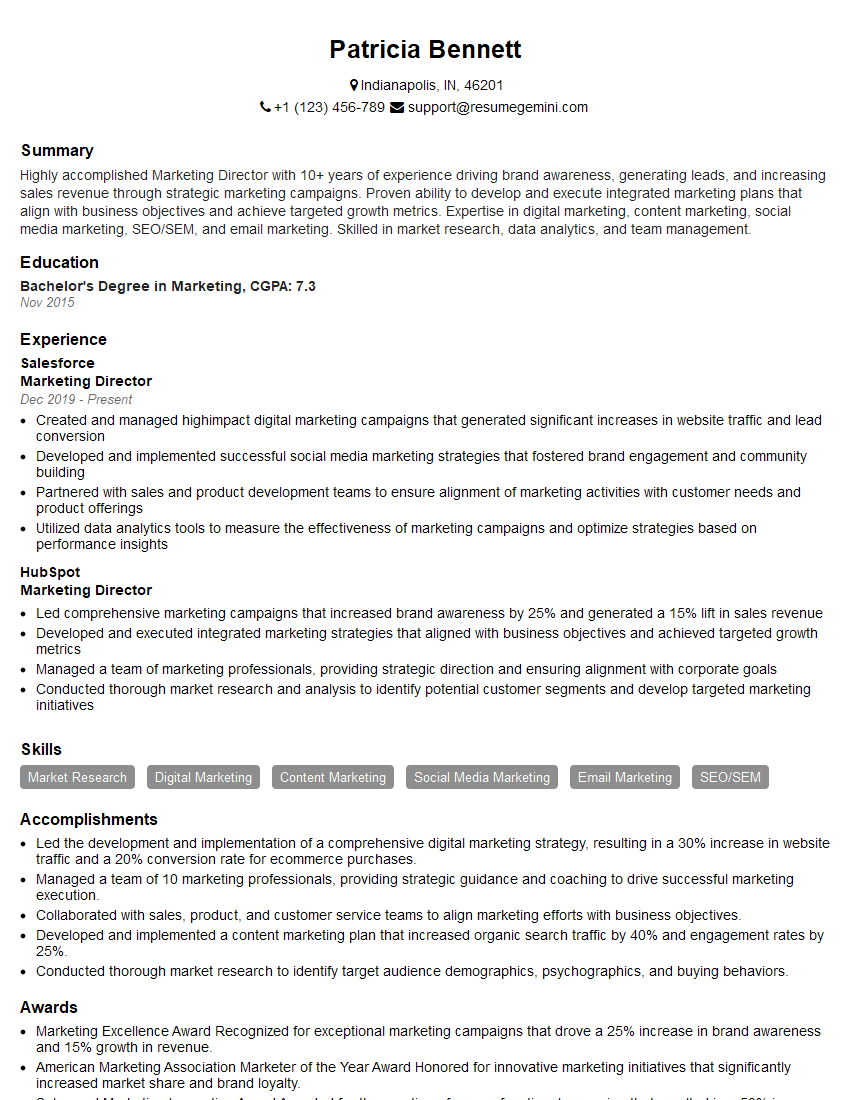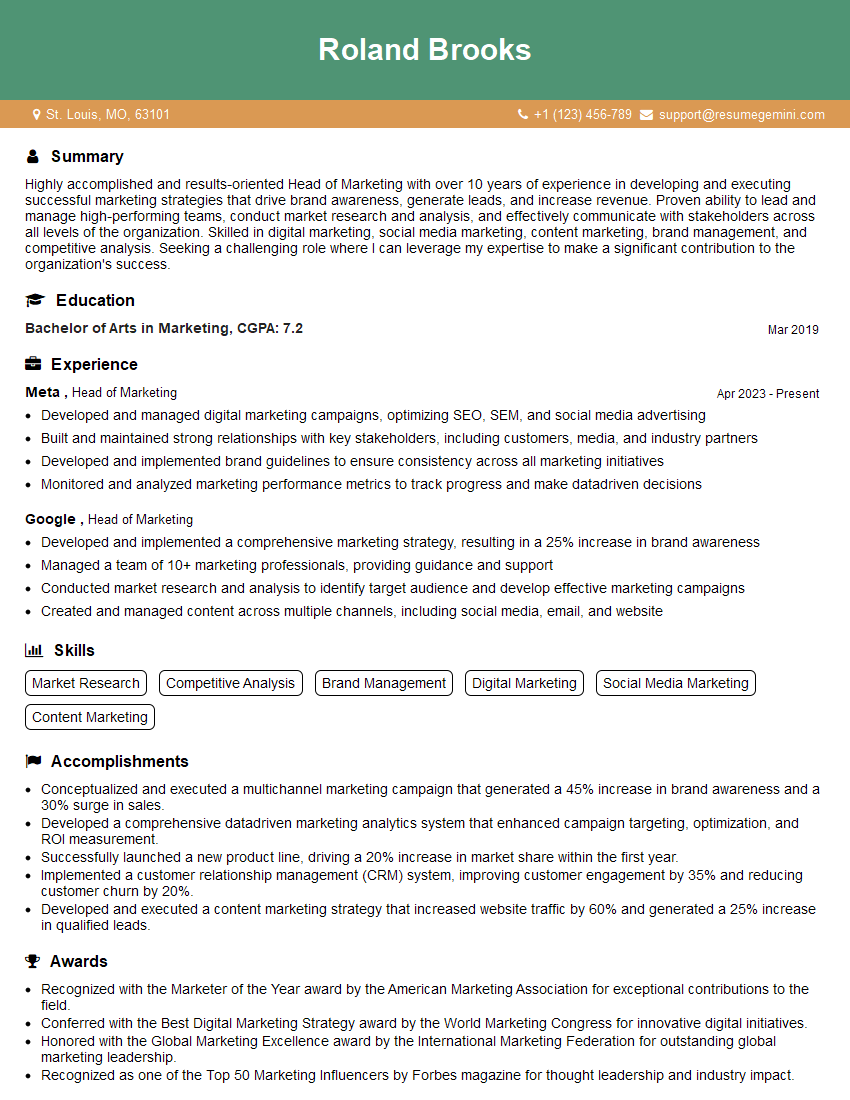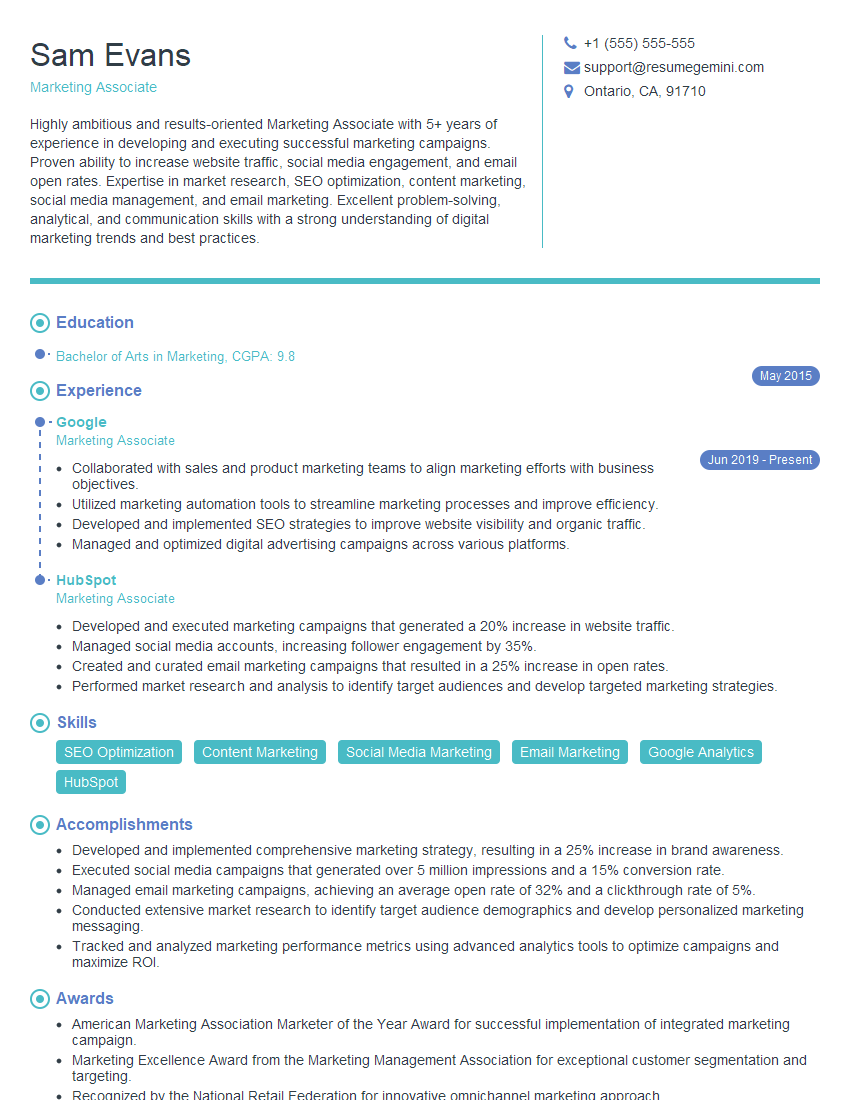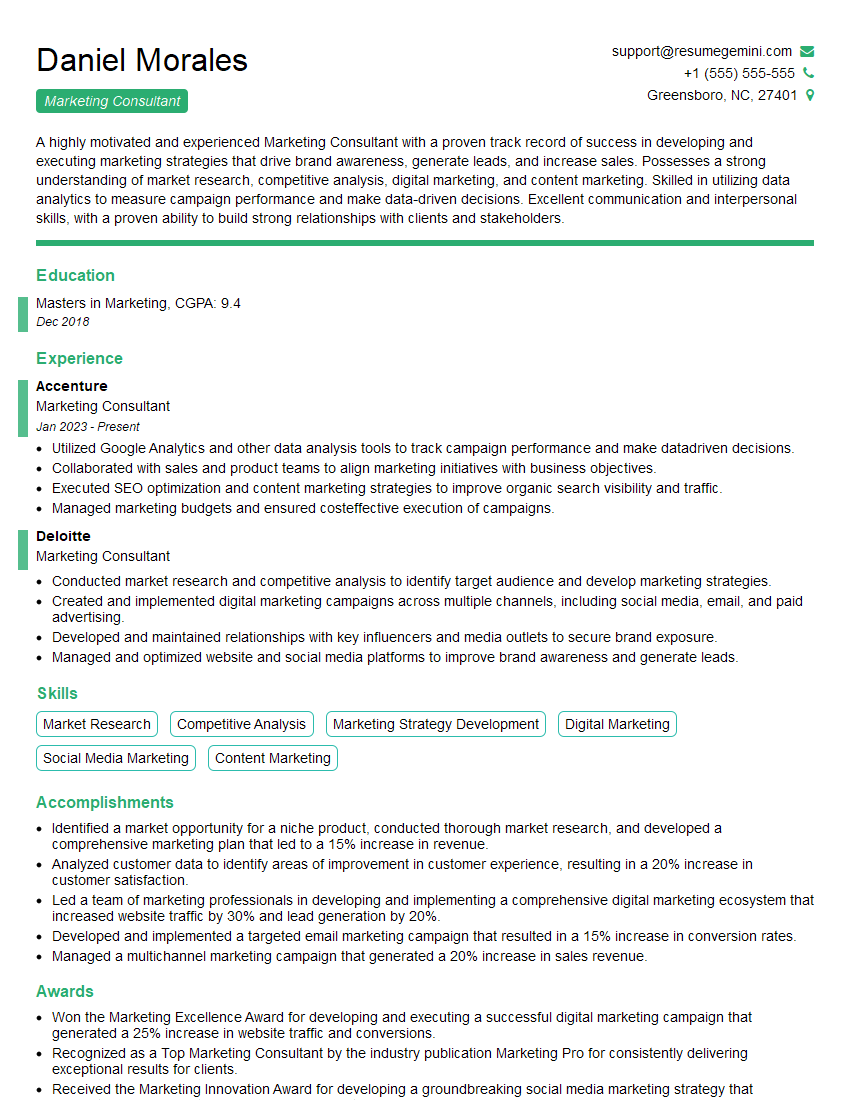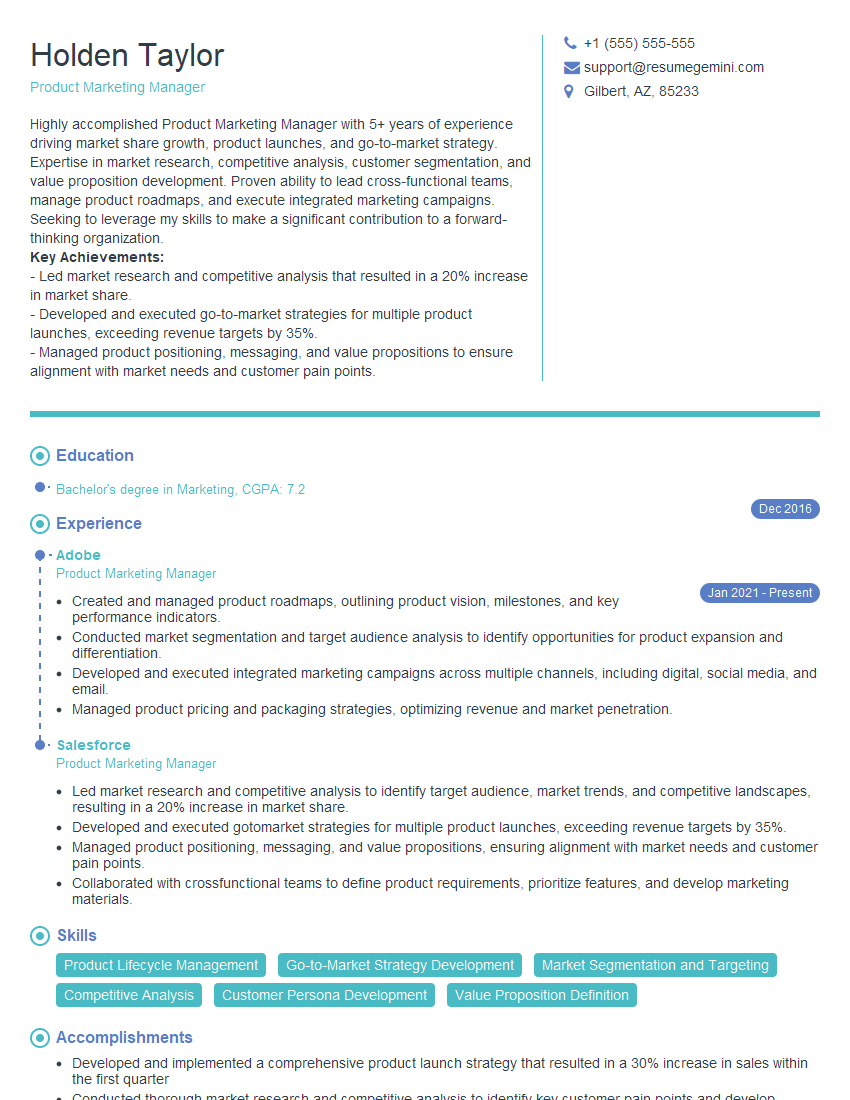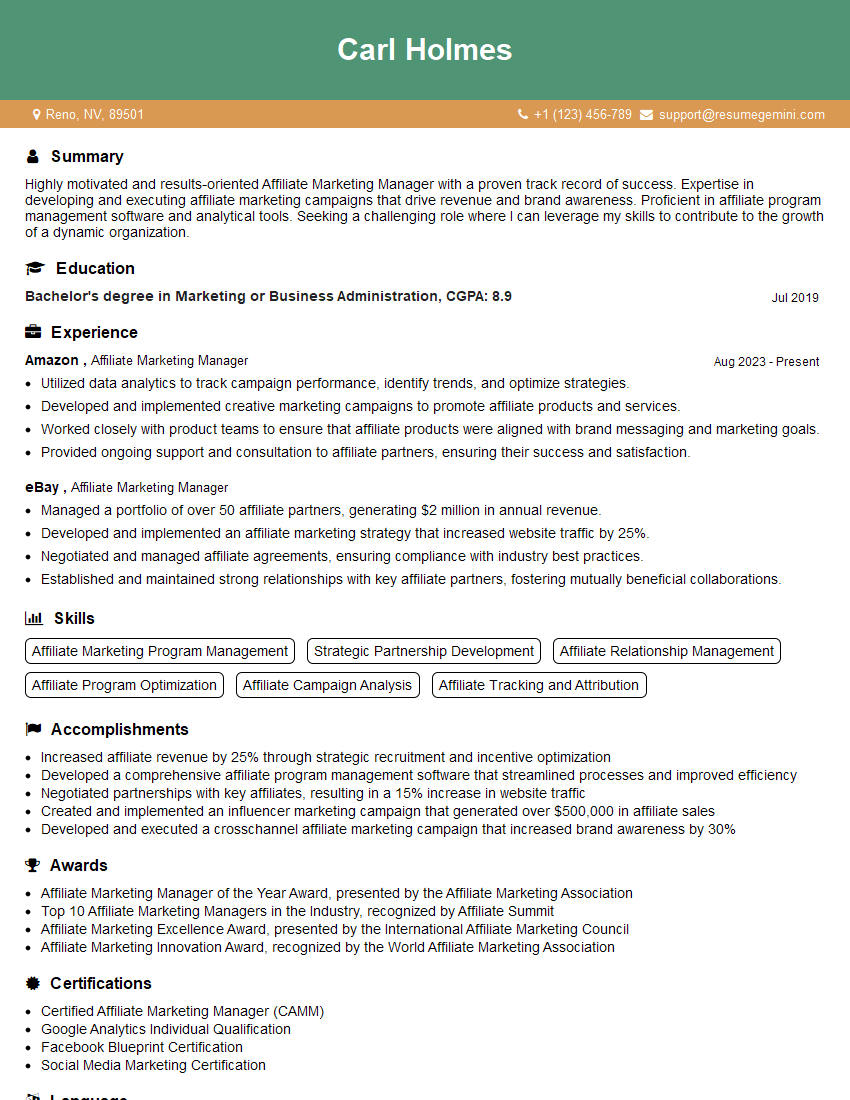Interviews are opportunities to demonstrate your expertise, and this guide is here to help you shine. Explore the essential Marking interview questions that employers frequently ask, paired with strategies for crafting responses that set you apart from the competition.
Questions Asked in Marking Interview
Q 1. Explain your understanding of the marketing mix (4Ps or 7Ps).
The marketing mix, often represented by the 4Ps or 7Ps, is a fundamental framework for developing and implementing a marketing strategy. The 4Ps – Product, Price, Place, and Promotion – are the core elements. The 7Ps extend this by adding People, Process, and Physical Evidence, particularly relevant for service-based businesses.
Product: This encompasses the goods or services offered, their features, benefits, branding, and packaging. For example, a company selling organic coffee might focus on fair-trade sourcing and sustainable packaging as key product differentiators.
Price: This refers to the pricing strategy – cost-plus pricing, value-based pricing, competitive pricing, etc. – and how it aligns with the target market and overall value proposition. A premium coffee brand might use value-based pricing to justify a higher price point.
Place: This is about distribution channels – online, retail stores, direct sales, etc. – and how the product reaches the customer. The organic coffee company might sell directly online and through specialty grocery stores.
Promotion: This covers marketing communications – advertising, public relations, sales promotions, content marketing, etc. – used to raise awareness and drive sales. The coffee company could run social media ads and influencer collaborations.
People: (7Ps) This focuses on the employees’ interaction with customers, emphasizing training and customer service to enhance the overall experience. A barista’s friendly demeanor is crucial for a positive customer experience.
Process: (7Ps) This refers to the systems and procedures involved in delivering the product or service, ensuring efficiency and customer satisfaction. A streamlined online ordering system for the coffee company is essential.
Physical Evidence: (7Ps) This encompasses the tangible aspects that customers experience, such as store design, packaging, or website aesthetics. The coffee shop’s ambiance and the coffee’s aroma contribute to this.
Effectively balancing these elements is key to a successful marketing strategy. Each element should be strategically aligned to achieve the overall marketing objectives.
Q 2. Describe your experience with SEO and SEM strategies.
I have extensive experience in both SEO (Search Engine Optimization) and SEM (Search Engine Marketing) strategies. SEO focuses on organic, unpaid search results, while SEM utilizes paid advertising to improve visibility.
My SEO experience involves keyword research, on-page optimization (meta descriptions, title tags, header tags, content optimization), off-page optimization (link building, social media marketing), and technical SEO (site speed, mobile-friendliness, schema markup). For instance, I successfully improved a client’s website ranking for relevant keywords by 30% within six months through a comprehensive SEO strategy.
In SEM, I have managed pay-per-click (PPC) campaigns on platforms like Google Ads and Bing Ads. This involved keyword targeting, ad copywriting, A/B testing, bid management, and campaign tracking and analysis to maximize ROI. For example, I managed a PPC campaign that generated a 25% increase in qualified leads within three months by implementing data-driven optimization strategies.
Q 3. How do you measure the success of a marketing campaign?
Measuring the success of a marketing campaign requires a well-defined set of Key Performance Indicators (KPIs) aligned with the campaign’s objectives. These KPIs can be broadly categorized into:
Website Analytics: Website traffic (unique visitors, page views, bounce rate), conversion rates (leads, sales), time on site, and customer acquisition cost (CAC).
Social Media Analytics: Engagement (likes, shares, comments), reach, follower growth, brand mentions, and sentiment analysis.
Sales and Revenue: Sales growth, revenue generated, return on investment (ROI), and customer lifetime value (CLTV).
Brand Awareness: Brand mentions, media coverage, and social media sentiment.
Lead Generation: Number of leads generated, lead conversion rates, and lead quality.
For example, a successful social media campaign might be measured by increased brand awareness (measured by social media mentions and reach), website traffic, and lead generation. It’s important to track these metrics consistently throughout the campaign and compare them to benchmarks or previous campaigns to assess the overall effectiveness.
Q 4. What is your experience with A/B testing and its applications?
A/B testing (also known as split testing) is a method of comparing two versions of a web page or marketing asset to determine which performs better. It involves randomly assigning users to see either version A or version B, and then analyzing the results to see which version leads to a higher conversion rate or other desired outcome.
My experience with A/B testing includes testing different headlines, call-to-action buttons, images, and website layouts. For example, I once A/B tested two different landing pages for a client – one with a benefit-driven headline and another with a feature-driven headline. The benefit-driven headline resulted in a 15% increase in conversion rates.
A/B testing is crucial for data-driven decision making and continuous improvement in marketing campaigns. By systematically testing different variations, marketers can identify what resonates best with their target audience and optimize their campaigns for maximum effectiveness. Tools like Google Optimize or VWO are commonly used to conduct A/B tests.
Q 5. Explain your understanding of customer segmentation and targeting.
Customer segmentation is the process of dividing a broad consumer or business market into sub-groups of consumers based on some type of shared characteristics. Targeting involves focusing marketing efforts on specific segments that are most likely to respond positively to your product or service.
For example, a clothing company might segment its market by demographics (age, gender, income), psychographics (lifestyle, values, interests), or behavior (purchase history, brand loyalty). They might then target a specific segment, such as young adults interested in sustainable fashion, with tailored marketing campaigns.
Effective segmentation and targeting enable businesses to create more relevant and resonant marketing messages, leading to improved efficiency and ROI. This requires a deep understanding of the target audience, their needs, and their preferences.
Q 6. How familiar are you with marketing automation tools?
I am highly familiar with several marketing automation tools, including HubSpot, Marketo, Pardot, and ActiveCampaign. These tools help automate repetitive marketing tasks, such as email marketing, social media posting, lead nurturing, and campaign tracking. This automation frees up time and resources, allowing marketers to focus on strategic initiatives.
My experience with these tools includes setting up automated email sequences, creating lead scoring systems, and using marketing automation to personalize customer journeys. For example, I implemented a lead nurturing campaign using HubSpot that resulted in a 20% increase in sales qualified leads.
Marketing automation tools are essential for efficiently managing large-scale marketing efforts, improving lead generation and nurturing, and enhancing customer relationships. They provide valuable data and analytics to track campaign performance and optimize marketing strategies.
Q 7. Describe your experience with social media marketing strategies.
My social media marketing experience spans various platforms, including Facebook, Instagram, Twitter, LinkedIn, and TikTok. I develop and implement strategies encompassing content creation, community engagement, paid advertising, and influencer marketing to achieve business objectives.
For example, I managed a successful Instagram campaign for a local bakery, increasing their follower count by 50% and driving a significant increase in store traffic through visually appealing content and targeted advertising. On LinkedIn, I helped a B2B company build brand awareness and generate leads by creating engaging thought leadership content and participating in relevant industry conversations.
A key aspect of my approach is data-driven decision making. I use analytics to track campaign performance, measure engagement, and optimize strategies for maximum impact. Understanding the nuances of each platform and tailoring content accordingly is crucial for successful social media marketing.
Q 8. What are your preferred methods for conducting market research?
My preferred market research methods are multifaceted and depend heavily on the specific goals and resources available. I generally favor a mixed-methods approach, combining quantitative and qualitative research techniques for a comprehensive understanding.
Quantitative Research: This involves gathering numerical data to quantify market trends. Examples include surveys (online or in-person), analyzing sales data, conducting A/B testing on marketing campaigns, and using website analytics (Google Analytics) to track user behavior. For instance, analyzing website bounce rates can reveal issues with landing page design or content relevance.
Qualitative Research: This focuses on gathering in-depth insights and understanding customer perceptions. Methods I frequently use include focus groups, in-depth interviews, and social media listening. For example, conducting focus groups can provide valuable feedback on a new product concept before launch.
Competitive Analysis: I always include a thorough competitive analysis to identify opportunities and threats. This involves researching competitors’ marketing strategies, pricing, and customer reviews.
The choice of methods is driven by the specific research question. For example, to assess the effectiveness of an advertising campaign, I’d prioritize quantitative metrics like click-through rates and conversions. To understand customer satisfaction with a product, qualitative methods like customer interviews would be more appropriate.
Q 9. How do you create and manage a marketing budget?
Creating and managing a marketing budget involves a strategic, data-driven approach. It’s not just about allocating funds; it’s about maximizing ROI. I typically follow these steps:
Define Marketing Objectives: Clearly state what the marketing activities aim to achieve (e.g., increase brand awareness, generate leads, drive sales). These objectives should be SMART – Specific, Measurable, Achievable, Relevant, and Time-bound.
Identify Key Marketing Activities: Based on the objectives, determine the necessary marketing channels and activities (e.g., content marketing, social media marketing, paid advertising, email marketing, events).
Allocate Budget: Allocate a budget to each activity based on its projected ROI and potential impact. I often use a combination of top-down and bottom-up budgeting to balance overall strategy with individual campaign needs. Tools like marketing dashboards can be very helpful.
Track and Monitor: Regularly track key performance indicators (KPIs) for each marketing activity to assess effectiveness and make adjustments. This allows for real-time optimization and ensures resources are used efficiently.
Reporting and Analysis: Generate regular reports demonstrating the return on investment for each marketing activity, and use these insights to optimize future budget allocation.
For example, if a social media campaign is underperforming, I would analyze the data to identify the root cause (e.g., poor targeting, ineffective ad copy) and reallocate budget to more successful channels.
Q 10. Describe your experience with content marketing and content creation.
My experience in content marketing and creation is extensive. I believe in creating high-quality, engaging content that resonates with the target audience and provides value. This involves understanding the customer journey and tailoring content to each stage.
Content Strategy: I begin by developing a comprehensive content strategy that aligns with the overall marketing goals. This includes identifying target keywords, defining content pillars, and creating a content calendar.
Content Creation: I work with a team (or independently, depending on the project) to create various forms of content, including blog posts, website copy, infographics, videos, and social media posts. The content is always optimized for search engines (SEO) and designed to be shareable.
Content Distribution: Effective content distribution is critical. This includes leveraging multiple channels like social media, email marketing, and paid advertising to reach the target audience.
Content Promotion: Content promotion involves actively engaging with the audience, building relationships with influencers, and utilizing other outreach strategies.
Content Analysis: Analyzing content performance is crucial to understand what resonates with the audience and what needs improvement. This includes tracking metrics like website traffic, engagement rates, and conversions.
For instance, I once created a series of blog posts and infographics explaining a complex technical product to a less technical audience, resulting in a significant increase in qualified leads.
Q 11. How would you handle a marketing campaign that is underperforming?
Handling an underperforming marketing campaign requires a systematic approach. Panic is the enemy of effective problem-solving. My steps would be:
Analyze the Data: Thoroughly review all available data, including website analytics, social media metrics, and conversion rates. Identify specific areas where the campaign is falling short.
Identify the Root Cause: Based on the data analysis, pinpoint the reason for underperformance. Is it poor targeting, ineffective messaging, insufficient budget, or something else?
Develop a Corrective Plan: Based on the identified root cause, create a plan to address the issue. This might involve adjusting the targeting parameters, revising the messaging, increasing the budget, or changing the campaign strategy altogether. A/B testing different elements can be crucial here.
Implement Changes: Implement the corrective plan, closely monitoring the results to see if the changes are effective.
Iterate and Optimize: Marketing is an iterative process. Continue to monitor and adjust the campaign based on ongoing performance data. Don’t be afraid to pivot if necessary.
For example, if an email marketing campaign has a low open rate, I might investigate subject line optimization or segmentation strategies to improve engagement.
Q 12. What are your thoughts on the use of influencer marketing?
Influencer marketing can be a powerful tool, but it requires careful planning and execution. My view is that it’s most effective when aligned with a clear strategy and used in conjunction with other marketing efforts.
Careful Selection: Choosing the right influencers is crucial. I would look for influencers who have a genuine following, high engagement rates, and a brand alignment that resonates with our target audience. Authenticity is key; forced endorsements can be detrimental.
Measurable Goals: Set clear, measurable goals for the influencer marketing campaign (e.g., increase brand awareness, drive website traffic, generate leads). Track key metrics to measure ROI.
Transparency and Disclosure: Transparency and clear disclosure of sponsored content are essential for maintaining trust with the audience.
Campaign Management: Effective management involves clear communication with influencers, setting deadlines, and providing creative direction.
I believe influencer marketing is most effective when integrated into a broader marketing strategy, not used in isolation. It’s a component, not the entire solution.
Q 13. Explain your understanding of conversion rate optimization (CRO).
Conversion rate optimization (CRO) is the process of improving the percentage of website visitors who complete a desired action (a conversion). This could be anything from making a purchase, filling out a form, or signing up for a newsletter.
My approach to CRO involves a data-driven, iterative process:
Data Analysis: Start by analyzing website traffic data to identify bottlenecks in the conversion funnel. Heatmaps and session recordings can be invaluable tools here.
A/B Testing: Conduct A/B tests to compare different versions of website elements (e.g., headlines, calls to action, images) to see which performs better. This allows for data-driven decision-making.
User Experience (UX) Optimization: Improve the overall user experience of the website to make it easier for visitors to navigate and complete desired actions. This includes ensuring the website is mobile-friendly, loads quickly, and is easy to use.
Personalization: Personalize the website experience to cater to individual user needs and preferences. This can improve engagement and increase conversions.
For example, by A/B testing different call-to-action buttons, I might discover that a button with a stronger verb and more compelling visual design increases conversions significantly.
Q 14. How do you stay up-to-date on the latest marketing trends?
Staying up-to-date on the latest marketing trends is crucial for remaining competitive. I utilize a variety of methods:
Industry Publications and Blogs: I regularly read industry publications, blogs, and websites that cover marketing trends. This includes publications like MarketingProfs, Neil Patel’s blog, and various publications from marketing technology companies.
Marketing Conferences and Webinars: Attending marketing conferences and webinars allows me to learn from experts and network with other professionals. This provides invaluable insights into emerging trends and best practices.
Social Media: Following key influencers and marketing thought leaders on social media platforms like Twitter and LinkedIn keeps me informed about the latest developments.
Online Courses and Certifications: I actively pursue online courses and certifications to enhance my skills and knowledge in specific areas of marketing.
Networking: Engaging in networking events, both online and in-person, provides opportunities to learn about current challenges and solutions in the industry.
By actively engaging in these activities, I can ensure I am always learning and adapting to the ever-changing landscape of marketing.
Q 15. Describe your experience with email marketing best practices.
Email marketing, when done right, is a powerful tool. My experience centers around crafting compelling campaigns that resonate with the target audience, leading to increased engagement and conversions. This involves a multi-pronged approach focusing on:
- List Segmentation: Instead of a blanket approach, I segment email lists based on demographics, behavior (past purchases, website activity), and preferences. This ensures highly targeted messaging, boosting open and click-through rates. For example, I’ve segmented audiences based on purchase history to send targeted promotions for complementary products.
- Compelling Content: I focus on creating value-driven content, offering useful information, exclusive discounts, or engaging stories. This moves away from solely promotional messaging. I always A/B test subject lines and email content to optimize performance.
- Mobile Optimization: With a large percentage of emails opened on mobile devices, responsiveness is crucial. I ensure all emails are optimized for seamless viewing across different screen sizes.
- Automation: I leverage automation tools to streamline processes, such as automated welcome emails, abandoned cart reminders, and post-purchase follow-ups. This enhances customer experience and drives sales.
- Performance Tracking & Analysis: I meticulously track key metrics like open rates, click-through rates, conversion rates, and unsubscribe rates to continuously optimize campaigns. This data-driven approach helps refine strategies for maximum impact.
For instance, in a previous role, I implemented an automated email sequence for abandoned shopping carts that resulted in a 20% increase in recovered sales.
Career Expert Tips:
- Ace those interviews! Prepare effectively by reviewing the Top 50 Most Common Interview Questions on ResumeGemini.
- Navigate your job search with confidence! Explore a wide range of Career Tips on ResumeGemini. Learn about common challenges and recommendations to overcome them.
- Craft the perfect resume! Master the Art of Resume Writing with ResumeGemini’s guide. Showcase your unique qualifications and achievements effectively.
- Don’t miss out on holiday savings! Build your dream resume with ResumeGemini’s ATS optimized templates.
Q 16. What are your skills in data analysis and interpretation in marketing?
Data analysis and interpretation are integral to my marketing approach. I’m proficient in using various tools and techniques to extract meaningful insights from marketing data. My skills encompass:
- Data Collection and Cleaning: I can effectively collect data from various sources (website analytics, CRM, social media, etc.) and clean it to ensure accuracy and reliability.
- Statistical Analysis: I use statistical methods to identify trends, correlations, and patterns within the data. For example, I might use regression analysis to understand the relationship between advertising spend and sales.
- Data Visualization: I utilize tools like Tableau and Excel to create insightful dashboards and reports that effectively communicate key findings to stakeholders. This allows for a clear understanding of campaign performance and areas for improvement.
- Attribution Modeling: I utilize various attribution models (e.g., last-click, multi-touch) to understand the contribution of different marketing channels to conversions, which helps allocate resources effectively.
In a recent project, I analyzed website traffic data to identify the most effective content marketing strategies, leading to a 15% increase in organic traffic.
Q 17. How would you develop a marketing strategy for a new product launch?
Developing a marketing strategy for a new product launch requires a structured approach. My process typically involves:
- Market Research: Thoroughly understanding the target audience, competitive landscape, and market trends is crucial. This involves analyzing demographics, psychographics, buying behaviors, and competitive offerings.
- Value Proposition Definition: Clearly articulating the unique value proposition of the new product is essential. What problem does it solve, and what makes it different from existing solutions?
- Target Audience Segmentation: Dividing the target audience into distinct segments based on shared characteristics enables personalized messaging and targeted campaigns.
- Marketing Channel Selection: Choosing the most effective channels to reach the target audience is key. This could involve a mix of digital marketing (SEO, SEM, social media, email), traditional marketing (print, broadcast), or public relations.
- Campaign Development: Creating engaging content, compelling visuals, and a clear messaging strategy are crucial for successful marketing campaigns. This also includes setting a clear budget and timeline.
- Launch Plan: A comprehensive launch plan outlines all pre-launch activities, launch day activities, and post-launch activities. This ensures a coordinated and impactful launch.
- Performance Measurement: Tracking key metrics (website traffic, sales, brand awareness) to monitor the campaign’s effectiveness and make necessary adjustments along the way.
For example, I once developed a launch strategy for a new SaaS product that included a comprehensive content marketing campaign, targeted social media advertising, and strategic partnerships, leading to exceeding our initial user acquisition goals by 30%.
Q 18. Describe your experience with brand building and management.
Brand building and management are paramount for long-term success. My experience focuses on creating a strong brand identity and managing its perception in the market. This includes:
- Brand Strategy Development: Defining the brand’s mission, vision, values, and personality is the foundation. I work with stakeholders to create a compelling brand story and ensure consistency across all touchpoints.
- Brand Positioning: Establishing the brand’s unique place in the market and communicating it clearly to the target audience. This involves defining its competitive advantages and differentiating factors.
- Brand Voice and Messaging: Creating a consistent and engaging brand voice across all communication channels. This ensures a unified and recognizable brand identity.
- Brand Guidelines: Developing and enforcing brand guidelines ensures consistency in visual elements (logo, colors, fonts) and messaging across all marketing materials.
- Brand Monitoring and Management: Regularly tracking brand mentions, analyzing sentiment, and addressing any negative feedback to maintain a positive brand reputation. This might involve using social listening tools.
In a previous role, I spearheaded a brand refresh initiative that resulted in a 15% increase in customer loyalty and a 10% improvement in brand perception, as measured by customer surveys.
Q 19. How do you measure brand awareness and brand equity?
Measuring brand awareness and brand equity requires a multi-faceted approach. Brand awareness refers to the extent to which consumers are familiar with a brand, while brand equity represents the overall value associated with a brand.
- Brand Awareness Measurement:
- Surveys: Measuring aided and unaided brand recall, assessing familiarity and recognition.
- Social Listening: Tracking brand mentions and sentiment on social media platforms.
- Website Analytics: Analyzing website traffic and engagement metrics, such as brand searches and time spent on site.
- Market Research: Conducting broader market research to understand brand perception and awareness among target audiences.
- Brand Equity Measurement:
- Customer Surveys: Assessing brand perception, customer loyalty, and willingness to pay a premium for the brand.
- Net Promoter Score (NPS): Measuring customer satisfaction and loyalty.
- Brand Valuation: Estimating the financial value of the brand, taking into account factors like revenue, profitability, and brand perception.
- Market Share Analysis: Tracking the brand’s market share to assess its competitive position.
A combination of these methods provides a holistic view of brand awareness and equity, informing strategic decisions regarding marketing investments and brand management.
Q 20. How do you handle conflicts or disagreements within a marketing team?
Conflicts within a marketing team are inevitable, but they can be productively resolved. My approach centers on:
- Open Communication: Encouraging open dialogue and active listening to understand each individual’s perspective and concerns.
- Collaborative Problem-Solving: Working together to find mutually acceptable solutions, focusing on the team’s common goals and objectives.
- Facilitation: When necessary, I act as a facilitator, helping team members to articulate their viewpoints, find common ground, and reach a consensus.
- Mediation: In cases of serious disagreement, I would work to mediate the conflict, ensuring fairness and objectivity.
- Focus on Objectives: Reminding the team of the overall goals and aligning individual efforts towards shared success.
I believe in fostering a respectful and collaborative team environment where diverse opinions are valued and used to create the best possible marketing strategies. I’ve successfully navigated disagreements in past teams by focusing on data-driven decision making and emphasizing the shared goals of the team.
Q 21. What is your experience with marketing analytics platforms (e.g., Google Analytics)?
I have extensive experience using marketing analytics platforms, particularly Google Analytics. My expertise includes:
- Website Traffic Analysis: Analyzing website traffic sources, user behavior, and conversion rates to identify areas for improvement.
- Goal Setting and Tracking: Setting up and tracking key performance indicators (KPIs) to measure the success of marketing campaigns.
- Data Segmentation: Segmenting website traffic based on various criteria (demographics, behavior, etc.) to identify key audience segments.
- Custom Reporting: Creating custom reports to monitor specific marketing initiatives and provide data-driven insights to stakeholders.
- Integration with Other Tools: Integrating Google Analytics with other marketing tools (e.g., Google Ads, social media platforms) for a comprehensive view of marketing performance. This also includes understanding and implementing Google Tag Manager.
I’ve successfully used Google Analytics to optimize website design, improve user experience, and enhance the effectiveness of digital marketing campaigns, leading to quantifiable improvements in website conversions and user engagement.
Q 22. How familiar are you with different marketing channels (online and offline)?
My familiarity with marketing channels is extensive, encompassing both online and offline strategies. I’m proficient in leveraging digital channels such as Search Engine Optimization (SEO), Search Engine Marketing (SEM), Social Media Marketing (including platforms like Facebook, Instagram, LinkedIn, and TikTok), Email Marketing, Content Marketing (blogging, video, infographics), and Influencer Marketing. I also possess a strong understanding of traditional offline channels, including print advertising (newspapers, magazines), broadcast advertising (radio, television), direct mail marketing, event marketing, and public relations.
My experience includes developing integrated marketing campaigns that blend online and offline approaches to maximize reach and impact. For instance, I once managed a campaign for a local bakery where we used social media contests to drive foot traffic to their physical store, supplementing online orders with in-store purchases. This integrated approach proved highly effective.
- Online Channels: SEO, SEM, Social Media Marketing, Email Marketing, Content Marketing, Influencer Marketing, Affiliate Marketing, Programmatic Advertising.
- Offline Channels: Print Advertising, Broadcast Advertising, Direct Mail, Event Marketing, Public Relations, Sponsorships, Telemarketing.
Q 23. Describe a time you had to adapt your marketing strategy due to unexpected circumstances.
During a product launch, we anticipated strong initial demand based on pre-orders. However, unforeseen supply chain disruptions drastically reduced our inventory. Our initial marketing strategy heavily emphasized online sales. To adapt, we immediately shifted focus. We:
- Paused performance-based advertising to avoid driving traffic to an out-of-stock product, reducing wasted ad spend.
- Increased transparency and communication with customers via email updates and social media posts, acknowledging the delay and managing expectations. This helped maintain customer loyalty.
- Emphasized pre-orders and waitlist sign-ups to build anticipation for the restock. We also offered incentives for joining the waitlist.
- Developed alternative messaging that focused on the product’s quality and unique features, rather than solely on immediate availability.
This agile response minimized negative impact on brand reputation and successfully built anticipation for the product’s return to stock. Ultimately, we learned the importance of having contingency plans and flexibility in our marketing strategies.
Q 24. What is your approach to building relationships with stakeholders?
Building strong stakeholder relationships is crucial for successful marketing. My approach is based on open communication, active listening, and mutual respect. I prioritize understanding each stakeholder’s goals and perspectives. I use a proactive communication strategy, providing regular updates and seeking their input throughout the process.
For example, when working with a client, I schedule regular meetings to discuss campaign performance, address concerns, and collaboratively refine strategies. I also maintain detailed documentation and reporting to keep stakeholders informed. I believe in transparency and addressing concerns promptly. With internal stakeholders, I foster a collaborative environment, encouraging feedback and open dialogue to ensure everyone feels valued and heard. Regular team meetings, informal check-ins, and clear communication channels are key.
Q 25. How do you prioritize tasks and manage your time effectively in a fast-paced environment?
In fast-paced environments, effective task prioritization and time management are paramount. I employ a combination of strategies, including:
- Prioritization Matrices: I use methods like the Eisenhower Matrix (urgent/important) to categorize tasks and focus on high-impact activities first.
- Time Blocking: I allocate specific time slots for focused work on critical tasks, minimizing interruptions.
- Project Management Tools: I utilize tools like Asana or Trello to manage tasks, deadlines, and progress, ensuring accountability and collaboration.
- Delegation: I effectively delegate tasks where appropriate, maximizing team efficiency.
- Regular Review and Adjustment: I regularly review my schedule and adjust priorities based on changing circumstances and emerging needs.
By combining these techniques, I can effectively manage competing demands, ensuring that critical tasks are completed efficiently and on time.
Q 26. Describe your experience working with marketing agencies or vendors.
I have extensive experience collaborating with marketing agencies and vendors, ranging from small boutique agencies to large multinational firms. My approach focuses on clear communication, well-defined scopes of work, and consistent performance monitoring. I develop strong working relationships based on trust and mutual understanding.
I ensure that contracts clearly outline deliverables, timelines, and payment terms. Regular meetings and progress reports are essential for maintaining transparency and addressing any issues promptly. I’m adept at providing constructive feedback to ensure alignment with the overall marketing strategy. For example, in a recent project, I worked closely with a design agency to create visually appealing marketing materials, ensuring alignment with our brand guidelines and target audience preferences. This collaborative approach resulted in high-quality deliverables and an efficient project workflow.
Q 27. What are your salary expectations for this role?
My salary expectations for this role are in the range of [Insert Salary Range]. This is based on my experience, skills, and the responsibilities associated with this position. I am open to discussing this further based on a detailed job description and the overall compensation package.
Q 28. Do you have any questions for me?
Yes, I have a few questions. First, could you elaborate on the company’s marketing goals for the next year? Second, what opportunities exist for professional development and growth within the company? Finally, what is the team structure and how does this role interact with other departments?
Key Topics to Learn for a Marking Interview
- Understanding Marking Schemes: Learn different types of marking schemes (e.g., holistic, analytic, criterion-referenced) and their applications in various assessment contexts.
- Reliability and Validity in Marking: Grasp the crucial concepts of reliability and validity in assessment and how to ensure fair and consistent marking practices. Explore strategies for minimizing bias and error.
- Practical Application of Marking Standards: Understand how to apply marking criteria consistently across different scripts or assignments. Practice applying different marking schemes to sample work.
- Feedback and Assessment: Explore effective methods for providing constructive feedback to learners based on marking results. Understand how to link feedback to improvements in learning.
- Technology in Marking: Familiarize yourself with various technologies used in marking, such as online marking platforms and automated assessment tools. Understand their advantages and limitations.
- Quality Assurance in Marking: Learn about procedures for ensuring the quality and consistency of marking, such as double marking, moderation, and standardisation processes.
- Addressing Challenges in Marking: Consider common challenges in marking (e.g., ambiguous responses, inconsistent handwriting) and develop strategies for addressing these effectively and fairly.
- Ethical Considerations in Marking: Understand the ethical implications of marking and the importance of maintaining impartiality and fairness in the assessment process.
Next Steps
Mastering the art of marking is crucial for career advancement in education and assessment-related fields. It demonstrates your attention to detail, fairness, and commitment to high-quality assessment practices. To enhance your job prospects, creating an ATS-friendly resume is essential. ResumeGemini is a trusted resource to help you build a professional and impactful resume that showcases your skills and experience effectively. Examples of resumes tailored to Marking roles are provided to help you craft your own compelling application.
Explore more articles
Users Rating of Our Blogs
Share Your Experience
We value your feedback! Please rate our content and share your thoughts (optional).
What Readers Say About Our Blog
Hello,
We found issues with your domain’s email setup that may be sending your messages to spam or blocking them completely. InboxShield Mini shows you how to fix it in minutes — no tech skills required.
Scan your domain now for details: https://inboxshield-mini.com/
— Adam @ InboxShield Mini
Reply STOP to unsubscribe
Hi, are you owner of interviewgemini.com? What if I told you I could help you find extra time in your schedule, reconnect with leads you didn’t even realize you missed, and bring in more “I want to work with you” conversations, without increasing your ad spend or hiring a full-time employee?
All with a flexible, budget-friendly service that could easily pay for itself. Sounds good?
Would it be nice to jump on a quick 10-minute call so I can show you exactly how we make this work?
Best,
Hapei
Marketing Director
Hey, I know you’re the owner of interviewgemini.com. I’ll be quick.
Fundraising for your business is tough and time-consuming. We make it easier by guaranteeing two private investor meetings each month, for six months. No demos, no pitch events – just direct introductions to active investors matched to your startup.
If youR17;re raising, this could help you build real momentum. Want me to send more info?
Hi, I represent an SEO company that specialises in getting you AI citations and higher rankings on Google. I’d like to offer you a 100% free SEO audit for your website. Would you be interested?
Hi, I represent an SEO company that specialises in getting you AI citations and higher rankings on Google. I’d like to offer you a 100% free SEO audit for your website. Would you be interested?
good

